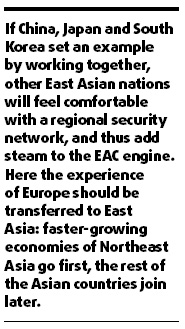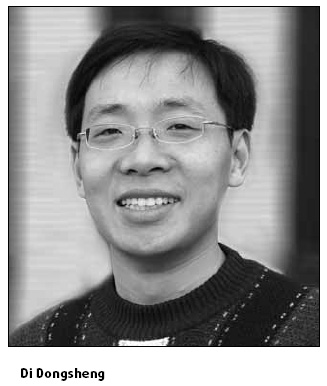Toward a community of mutual interest
Is it really possible to form an East Asian community (EAC) as Japanese Prime Minister Yukio Hatoyama has proposed? People in the region, especially China, have been debating this ever since Hatoyama suggested this after assuming office two months ago.
Many think an EAC is a daydream given the disparate political and economic systems and different levels of development in the region's countries. Some say how can we forget the long history of war and hatred between China and Japan, while others are not ready to even consider Hatoyama's proposal because they think the Democratic Party of Japan's (DPJ) government will not last long enough.
But Di Dongsheng, a lecturer in international relations at the Renmin University of China, considers the proposal as a strategic opportunity for China's peaceful development. He says an EAC will give China the chance to work with Japan and forge deeper regional integration and change the geopolitical and geo-economic structure of not only the western Pacific region, but also the rest of the world.
The prevailing diplomatic, security and economic situations, according to Di, put China in a vulnerable position. On the political and security front, the deep-set suspicion and so called "security dilemma" between China and Japan have caused many a dispute, which players outside the region have used to their advantage to further their interests in Asia.

On the economic and financial front, China and Japan, as well as the other economies in East Asia are part of the US-led globalization: They produce mainly for the American and European markets and try to save their hard-earned money by holding US dollars at close-to-zero return rate.
Thirty years ago China tried to catch up with the major economies in the region by copying their growth model. Di says it's true that the export-oriented model has propelled China's economic growth over the past decades. But he argues that we cannot depend on it forever, and this is the right time to effect a change.
China's condition today is comparable to Ellie, the female mammoth in Ice Age: The Meltdown. Growing up among opossums, Ellie is convinced that she, too, is one of them and behaves like her marsupial brothers. China now has to wake up to its strength and find its own path of growth from here.
China and Japan can play the most vital role in an EAC. But to do that, they have to change their development models and stimulate demand in the region as well as marginalized societies across the globe so that East Asia no longer depends on Western markets, Di says. This will make the world truly multi-polar, and enable countries in the region to decide how best to enhance their political and economic development and security.
"Hatoyama's proposal is revolutionary," Di says. It has the potential of not only opening up a new path for Japan, but also weakening the US-Japan alliance, which is the bedrock of US containment and hedging policy against China.
US policymakers, not to mention the conservatives in Japan, do not want see the DPJ in power. China's supportive policy, especially timely and concrete measures in response to the Japanese proposal, could help change Japanese people's expectations about the future of their country and East Asia. If the new path proves successful - if it can ensure Japan's security and dignity and revitalize its economy - it will help the DPJ to stay in power long enough to make fundamental and irreversible changes in Japanese society and bureaucratic system, something that is already on its way.
Europeans started their integration from co-managing their coal and steel industries, followed by free trade, unified tariff, a common market and finally a common currency, but a common foreign and security policy still is a thorny issue for them.
Di argues that European approach to regional integration is basically the product of Europe's political and social conditions. And since East Asia's background is totally different from Europe, their experiences should not limit our thoughts and vision in our efforts to build a regional community.

Perhaps the most practical way of forming an EAC would be to reverse the European Union (EU) pattern. East Asian countries can begin their integration from the most sensitive areas - security and politics - because their different development levels make economic integration difficult at the outset.
Aside from setting up a strategic mutual trust mechanism, China, Japan and South Korea can also establish a common energy security system. They could consider cooperation among their maritime forces, too, to fight piracy and other threats in the Indian Ocean and the Malacca Straits.
If China, Japan and South Korea set an example by working together, other East Asian nations will feel comfortable with a regional security network, and thus add steam to the EAC engine. Here the experience of Europe should be transferred to East Asia: faster-growing economies of Northeast Asia go first, the rest of the Asian countries join later.
The EAC is only an idea at present. The founder members have to flesh out arguments, thrash out details and lay out rules and regulations. They have to decide which other countries can be part of the community and in what capacity.
Shall an EAC be open? Di's answer is no. He regards the so-called concept of "open Asia" as a betrayal of Asian interests. Regionalization is a process of building boundaries against non-regional players. Neither the EU nor NAFTA has any place for Asian countries. So why should Asians keep a back door open for them? The basic idea of an EAC should be to "draw Japan back and keep the US out".
The sensitivity of such a suggestion - integration of China and Japan into a community - is not lost on Di. The Japanese army's atrocities during the 1930s and 1940s have left a permanent scar in the hearts and minds of Chinese, Koreans and people of other Asian countries. From time to time Japanese leaders, especially former prime minister Junichiro Koizumi, have reopened those wounds by visiting the Yasukuni Shrine, which pays homage to class-A war criminals, or through other actions.
That's why Chinese are wary of any Japanese move. Some even say the proposed EAC reminds them of the notorious "Greater East Asia Co-prosperity Sphere" that the Japanese tried to impose on the region during World War II to exploit and suppress people in other Asian countries.
But Di is not the first Chinese scholar to suggest that China look beyond historical issues and forge closer ties with Japan.
In the early years of this decade, several scholars, including Di's doctorate degree supervisor, Shi Yinhong, published a series of papers expressing similar views, which later came to be known as "new thoughts on China-Japan relations".
The articles published in Strategy and Management, a Beijing-based journal that wound up in 2005, drew harsh criticisms, with many people even calling them traitors. Di feels sorry for these people, and says Shi is as loyal to the nation as any other Chinese. "Shi was misunderstood for saying something different from everybody else."
Di hastens to add that he is neither pro-Japan, nor anti-US. His ideas have nothing to do with his personal feelings. They are all about national interest and real politics. Japan has to apologize for its war crimes to heal its neighbors' wounds, he says, while Asian people should overcome the sorrows and humiliation of history if they want to be a united force and grow stronger.
(China Daily 11/19/2009 page9)














